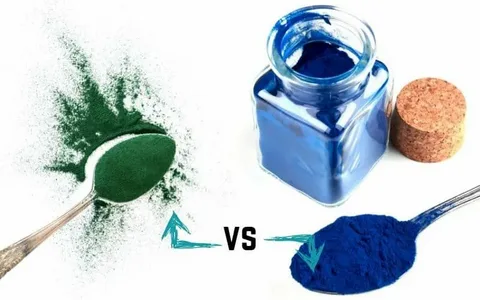Spirulina has become one of the most recognized superfoods in the wellness world—and for good reason. Packed with essential nutrients, antioxidants, and plant-based protein, spirulina supports immunity, energy, and overall wellness. However, if you’ve looked into incorporating it into your routine, you’ve likely come across two variations: blue spirulina and green spirulina. But what’s the real difference between the two? And which one is right for your health goals?
This article explores blue vs green spirulina—from nutritional content to potential uses—so you can make an informed decision as a health-conscious consumer.
What Is Spirulina? A Quick Primer
Spirulina is a type of blue-green algae that grows in both saltwater and freshwater environments. It has been consumed for centuries due to its dense nutritional profile, boasting protein, B vitamins, iron, and antioxidants.
Spirulina is typically harvested and dried into a powder or compressed into tablets. It comes in two primary forms:
- Green Spirulina: Whole spirulina biomass, containing the full spectrum of its natural compounds.
- Blue Spirulina: A purified extract from green spirulina, primarily containing phycocyanin—a powerful antioxidant pigment responsible for its vibrant blue color.
Understanding the distinctions between these two forms is key to determining which aligns with your wellness needs.
Nutritional Comparison: Blue vs Green Spirulina
Green Spirulina
Green spirulina is the complete algae, meaning it includes all its nutrients, including:
- High-quality plant-based protein (up to 60–70%)
- B vitamins, iron, calcium, and potassium
- Chlorophyll, which supports detoxification
- Phycocyanin (the same antioxidant found in blue spirulina)
Its nutritional completeness makes it ideal for those seeking whole-food supplementation to support immunity, joint health, and energy levels—especially important for older adults and busy professionals.
Blue Spirulina
Blue spirulina, by contrast, is extracted specifically for phycocyanin, which gives it a stunning blue hue. While it’s rich in antioxidant power, it lacks the protein, chlorophyll, and other micronutrients found in the whole form.
It’s often used more for:
- Antioxidant supplementation
- Smoothie or food coloring
- Energy support and oxidative stress relief
This blue vs green spirulina comparison explores both forms in greater depth, with insights into how they can complement different lifestyles.
Taste and Appearance
Green spirulina has a distinct earthy, oceanic taste—similar to seaweed. While it’s packed with nutrients, its bold flavor can be off-putting for some. It usually appears dark green and mixes into drinks or recipes with a strong hue and scent.
Blue spirulina, being an extract, has a much milder taste. It is visually appealing—vibrant electric blue—and is popular among wellness influencers and smoothie bowl creators who want to add color without a strong flavor.
For those sensitive to taste but still seeking nutritional benefits, spirulina tablets may be the best option.
Health Benefits Breakdown
Green Spirulina Supports:
- Immune Function: Thanks to its wide array of micronutrients and antioxidants.
- Joint & Bone Health: Rich in minerals and anti-inflammatory compounds.
- Detoxification: Chlorophyll aids in removing heavy metals and toxins.
- Energy Levels: B vitamins and protein support sustained energy and muscle recovery.
Blue Spirulina Supports:
- Antioxidant Defense: Phycocyanin fights free radicals, reducing oxidative stress.
- Skin Health: Antioxidants may improve skin tone and texture.
- Inflammation Control: Helpful for active individuals or older adults with joint stiffness.
How to Choose the Right Spirulina for You
When choosing between blue and green spirulina, ask yourself:
- Do you want complete nutrition in one supplement? Go with green spirulina.
- Do you want a mild flavor and strong antioxidant punch? Opt for blue spirulina.
- Do you need something taste-free and easy to take daily? Consider spirulina tablets.
Ultimately, both types of spirulina offer incredible health benefits—it’s about which one matches your goals and preferences.
Choosing a Trustworthy Brand
Spirulina’s benefits are only as good as the quality of the product. Look for:
- USDA-certified organic sources
- No fillers, binders, or artificial ingredients
- Transparent sourcing and third-party testing
BioOptimal Supplements is a trusted leader in premium superfood supplementation. Their organic spirulina tablets are an ideal solution for individuals seeking a high-quality, convenient source of whole-food spirulina—without the taste.
Final Thoughts: Which Spirulina Is Best for You?
The choice between blue vs green spirulina comes down to what you need from your supplement. Green spirulina offers a full spectrum of nutrition, while blue spirulina delivers targeted antioxidant power with a milder taste.
Both can be valuable additions to your wellness routine—especially when sourced from trusted brands like BioOptimal Supplements. Whichever path you choose, spirulina is a simple yet powerful way to support a vibrant, active lifestyle.


